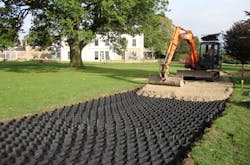Service Road Offers Low-Impact Access and Tree Root Protection
Permeable, Low-Impact Service Road
Copt Hewick Hall is a privately owned ‘special interest’ building in North Yorkshire, England on 86 acres of land. As part of an extensive renovation, a new service road was required for vehicles to access areas of the estate. A major concern was protecting large, mature trees from root damage during construction of the road. Relatively poor soils meant additional reinforcement would be required to support vehicles over the soft ground. A road solution was sought to minimize depth of excavation, support heavy vehicles over soft sub grades, and prevent expected loading stresses that would cause compaction and potential damage to the trees’ Critical Root Zone.
What is a Critical Root Zone?
The minimum area beneath a tree that must remain undisturbed to preserve a sufficient amount of root mass in order to assure the tree’s survival is the Critical Root Zone/tree protection zone. When construction equipment and vehicles intrude a tree’s Critical Root Zone, they can cause negative impacts to the soil environment including compaction of the soil, damage to near-surface roots and ultimately endanger the structural integrity of the tree. The majority of a tree’s root system is contained within the top three feet of the surface, and construction excavation and compaction can damage or even destroy roots to the point where trees may not survive.
Less Excavation, Less Loading Stress
The Presto Geosystems GEOWEB® Soil Confinement System was chosen for the access road. Its ability to reduce base requirements at least 50% results in less excavation and less disturbance to the subgrade soils. Loads are distributed laterally, not vertically, over the roadway reducing point loads and compaction of the subsoil. GEOWEB roads perform as a load supporting structural layer, reducing loading stresses off of the underlying soil and Critical Root Zone. With the permeable aggregate infill planned for the site, the roadway also allows natural water infiltration.
Installation Sequence & Components
The service road installation consisted of a geotextile underlayment, the GEOWEB material, and aggregate infill. The completed road was finished with concrete decorative edging.
Excavation: Only 8-inches of subgrade needed to be excavated compared to 20-inches required for conventional road construction and sub-grades of similar CBR value. That 60% reduction saved 12-inches of excavation.
Geotextile Soil Separation Layer: A 10 oz geotextile was installed as a separation layer between the subgrade and the aggregate fill—offering a good balance between infiltration of water from the permeable surface to the subgrade, and strength.
GEOWEB Surface Layer: GEOWEB panels were expanded and connected with weather-resistant ATRA® keys. Temporary anchors held the panels open for infilling. Bends in the roadway were accommodated by over-expanding the outer cells and under-expanding the inner cells until the desired radius was achieved. Once secured in position, the GEOWEB panels were infilled with aggregate—and the cells over-filled slightly to ensure a slight pavement layer wear course (0.5 inches) once compaction was completed.
Presto Geosystems | 920-738-1328 | [email protected] www.prestogeo.com







